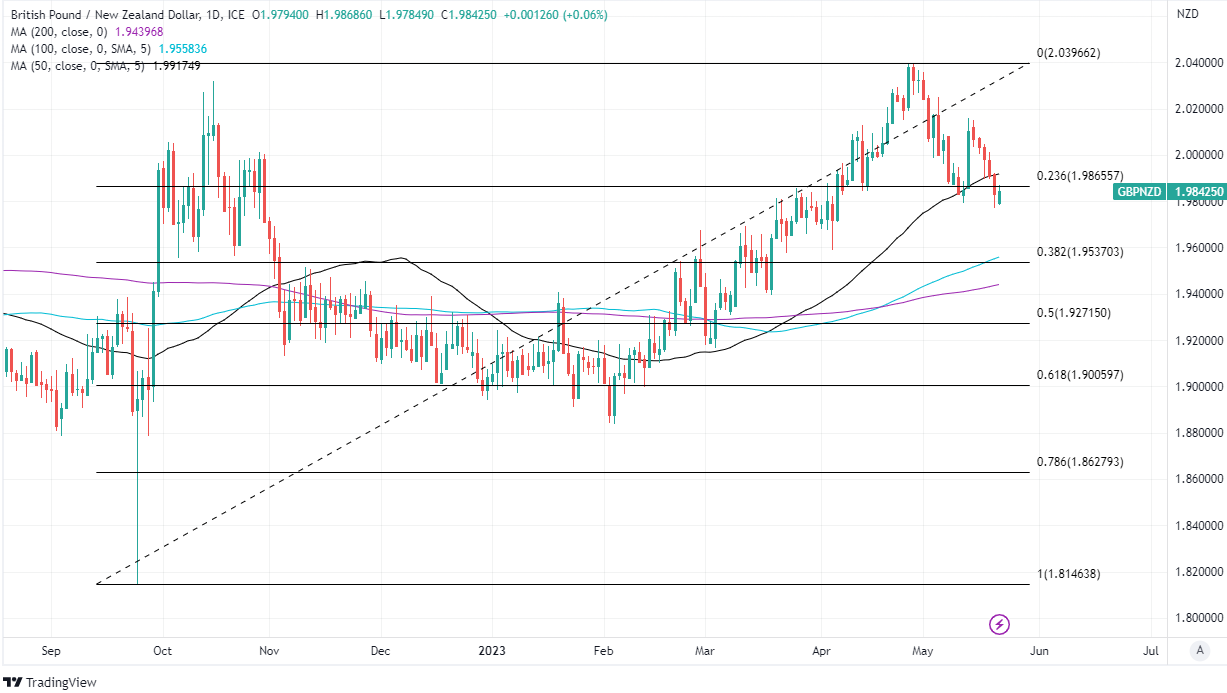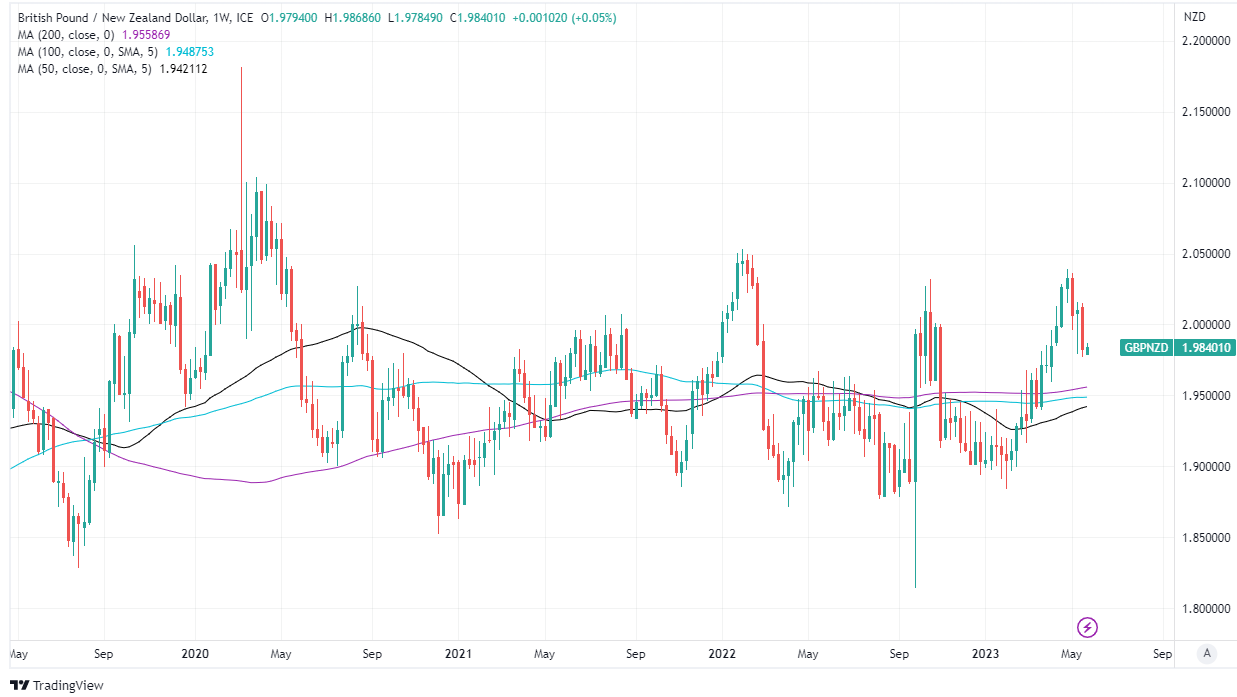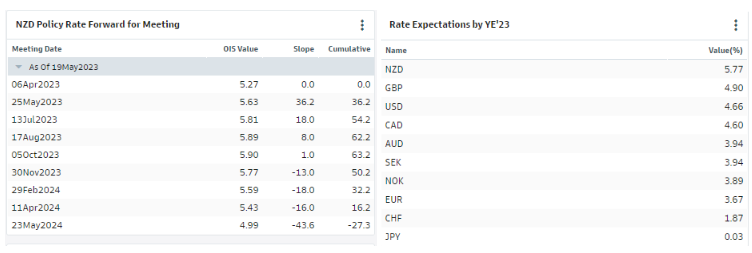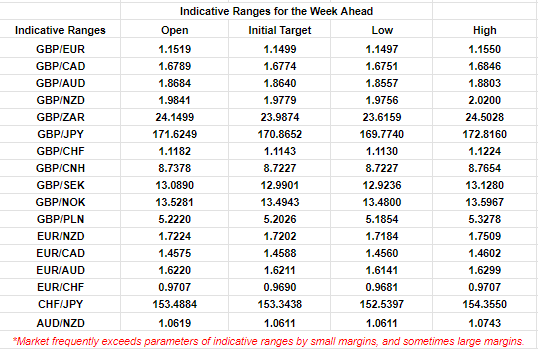GBP/NZD Week Ahead Forecast: Room for a Rebound
- Written by: James Skinner
- GBP/NZD looking for a foothold near to May lows
- After Kiwi tops G10 & G20 boards ahead of RBNZ
- Scope for rebound if maintains April's steady pace
- But UK inflation figures & other data posing risks

Image © Adobe Stock
The Pound to New Zealand Dollar exchange rate was ridden down to the lowlands of its May range last week but could get an opportunity rally back above the 2.0 level in the days ahead if either UK economic data is obliging, or if the Reserve Bank of New Zealand (RBNZ) stays April's interest rate course.
Only just recently a long-shot contender for outperformance in the major currency stable, New Zealand's Dollar outperformed most major counterparts on Monday after leading the field throughout last week to top the board for the period while solidifying its hold on the top spot for the recent month.
New Zealand Dollar gains have made it the hands-down outperformer in both G10 and G20 groupings in price action that followed closely behind the latest inflation expectations survey released by the RBNZ barely more than a week ago, and the new budget announced in Wellington last Thursday.
"On our reckoning, last week’s Budget delivered fiscal easing equivalent to 1½-2% of GDP and RBNZ may feel a need to respond to this," says Adam Cole, chief currency strategist at RBC Capital Markets, who advocated on Monday that clients sell GBP/NZD.
 Above: Pound to New Zealand Dollar rate shown at daily intervals with selected moving averages and Fibonacci retracements of September 2022 recovery indicating possible areas of technical support for Sterling. Click image for closer inspection.
Above: Pound to New Zealand Dollar rate shown at daily intervals with selected moving averages and Fibonacci retracements of September 2022 recovery indicating possible areas of technical support for Sterling. Click image for closer inspection.
Compare GBP to NZD Exchange Rates
Find out how much you could save on your pound to New Zealand dollar transfer
Potential saving vs high street banks:
NZ$53.50
Free • No obligation • Takes 2 minutes
Many analysts say the spending plans announced last week are likely to further boost an economy that Reserve Bank of New Zealand policymakers have characterised as overheating due to the current high levels of inflation.
Meanwhile, rates asked and offered in interest rate derivative markets have shifted to imply that investors now see a high risk of the RBNZ raising its cash rate by as much as half a percentage point this Wednesday as a result, which would lift the benchmark for borrowing costs to 5.75%.
"Responding to the cyclone is absolutely the right thing to do," says Sharon Zollner, chief economist at ANZ, who says the RBNZ is likely to raise its cash rate to 5.5% on Wednesday but acknowledges the risk of a larger move.
"But current macroeconomic conditions mean that because this isn’t going be paid for with higher taxes or more significant reprioritisations, it implies more macroeconomic stimulus, more pressure on CPI inflation, and therefore upside risk to the OCR outlook," she adds.
Source: Goldman Sachs Marquee.
Expectations implied in derivative markets suggest around a 50% probability of a cash rate increase to 5.75% having been backed into New Zealand Dollar exchange rates in recent days, meaning the Kiwi might be susceptible to corrective losses if the RBNZ simply stays its earlier course on Wednesday.
"It’s all about the forward guidance, best illustrated in the OCR track," says Jarrod Kerr, chief economist at Kiwibank.
"We think the RBNZ’s forward guidance, best illustrated in the OCR track, may do two things," he adds.
Kerr and colleagues forecast an increase to 5.5% for the cash rate on Wednesday but expect the RBNZ to balance this with forward guidance that suggests a risk of further increases later in the year and rules out the prospect of interest rate cuts anytime soon.
Above: Quantitative model estimates of ranges for selected pairs this week. Source Pound Sterling Live. Click the image for a more detailed inspection.
Compare GBP to NZD Exchange Rates
Find out how much you could save on your pound to New Zealand dollar transfer
Potential saving vs high street banks:
NZ$53.50
Free • No obligation • Takes 2 minutes
It's not clear if that would be enough to cause losses for the Kiwi though it might be safe to assume that it would make an extension of its nascent rally difficult, meaning that Wednesday's decision could help the Pound to New Zealand Dollar rate to stabilise near Monday levels, even if it doesn't enable a recovery.
Much depends for Sterling, however, on Wednesday's UK inflation figures and what they imply about the journey back to the two percent target of the Bank of England (BoE) following an eight-month period over which annual price growth has remained at a double-digit percentage.
"Base effects alone should ensure a very sharp fall in annual inflation in the UK and assuming this materialises, we expect a shift in the rhetoric from BoE officials to recognize a greater risk that rates have peaked," RBC Capital Markets' Cole said on Monday.
The economist consensus and many individual forecasters say that inflation is likely to fall faster than the BoE anticipates on Thursday, suggesting downside risk to market expectations for Bank Rate to be lifted from its current 4.5% over the coming months.
 Above: Pound to New Zealand Dollar rate shown at weekly intervals with selected moving averages. Click image for closer inspection.
Above: Pound to New Zealand Dollar rate shown at weekly intervals with selected moving averages. Click image for closer inspection.
A steep and decisive fall in inflation on Wednesday might act like a banana skin for Sterling, leading to knee-jerk losses, but there is a case to be made for it to benefit once the dust settles if inflation does decline in a meaningful way.
This is because return to the 2% target would portend an eventual recovery of the purchasing power lost since the middle of 2021 when inflation first rose above the target, and especially with Bank Rate being at its highest level since soon after the turn of the Millenium.
"The inflation number is critical for all central banks of course but for the BoE in particular, who are banking on a steep drop in inflation over coming months. If we get a higher than expected print on this number that will put a lot of pressure on the BoE," says Brad Bechtel, global head of FX at Jefferies.
Wednesday's inflation figures are the highlight of the week for Sterling, their release is followed by public appearances from BoE Governor Andrew Bailey on the same day, and bookended by the S&P Global PMI surveys for May and retail sales figures for April.
Compare GBP to NZD Exchange Rates
Find out how much you could save on your pound to New Zealand dollar transfer
Potential saving vs high street banks:
NZ$53.50
Free • No obligation • Takes 2 minutes






